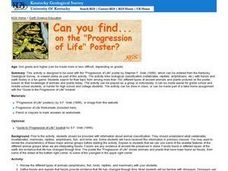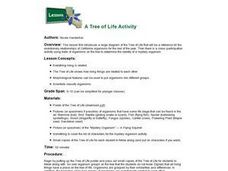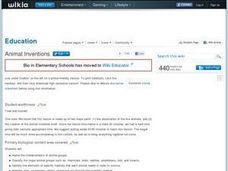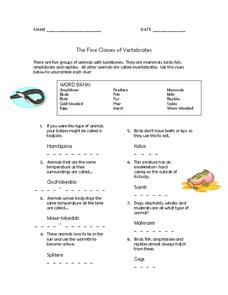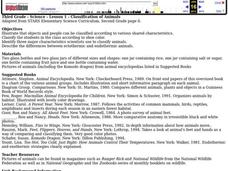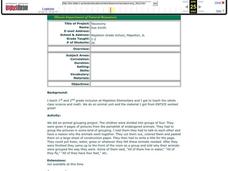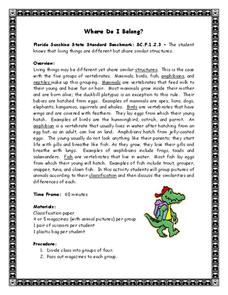Curated OER
Verterbrate Classification
Students are introduced to the broad categories of vertebrates including fish, amphibians, reptiles, birds and mammals. They identify the characteristics of each group and then view slideshows and video of example species.
Curated OER
Are You One Of Us?
Students discover how to classify things based on their similarities and differences. Students give the characteristics of insects and create a classification list. Given examples of various types of insects, students classify them...
Curated OER
A Planet Full of Animals
Students study animals and practice classifying them through observation activities. In this animal classification instructional activity, students complete a KWL chart about animals. Students then sort pictures of animals into chart...
Curated OER
Sunken Millions
This PowerPoint features a game based on the animal life. The interactive slides include 20 questions about animal needs, animal groups, and animal traits. The questions include multiple choice answers and 4 different levels of...
Curated OER
Science - How are Animals Grouped?
In these categorizing animals worksheets, learners complete 20 true or false statements about animal groups. Students then classify the animals in the box into the correct column. Learners write the letter of the correct answer for the...
Curated OER
How Are Animals Grouped?
In this animal grouping worksheet, students compare and contrast the characteristics of mammals, birds, and fish. This worksheet has 9 fill in the blank questions in a graphic organizer.
Curated OER
Climate Types
In this weather worksheet, middle schoolers identify the type of vegetation found in particular regions across the United States. Then they list the six groups of climates in the Köppen Classification System. Students also describe the...
Curated OER
Classy
Students explore the classification system in this seven lessons unit. The diversity of life forms and their characteristics are examined using a microscope. Kingdoms, classes, and families are investigated.
Curated OER
She Sells Sea Shells in Illinois??
Second graders sorted shells first by methods they thought appropriate and then were instructed on the scientific method of classification by univalve and bivalve. Students then sorted paper shells as a method of assessing knowledge. It...
Curated OER
Do You Have the Key?
Students practice using a dichotomous key. In this classification instructional activity, students read an article about scientific exploration and identification of new species. They use a dichotomous key to identify objects and create...
Curated OER
Can You Find...on the "Progression of Life" Poster?
Students examine and analyze a poster that presents various types of animals throughout the ages. They determine biological classification with fossils and earth history in a game.
Curated OER
A Tree of Life Activity
Young scholars solve a mystery of the identification of a unknown organism by comparing its morphological characteristics to those in a tree of life classification poster. They compare the observable characteristics of the specimen and...
Curated OER
Classification of Living Things
In this biology learning exercise, students identify and locate various vocabulary terms relating to the classification of living things. There are 28 biology terms located in the word search.
Curated OER
The Beluga Whale, Otters
In these internet activity worksheets, students complete research related to the Beluga Whale and otters. Student are able to answer questions by following directions to help them navigate around a website.
Curated OER
Animal Inventions
Students name the characteristics of animal groups. Students classify the major animal groups such as: mammals, birds, reptiles, amphibians, fish, and insects. They identify the elements of specific habitats that each animal needs in...
Curated OER
Steppin' Out: Using Inquiry to Challente Alexander's Stride Analysis
Young scholars distinguish between walking, jogging and running trackways in humans. They analyze the phylogenetic progression of the leg position as described by pace width and angulation, comparing amphibians, reptiles and mammals....
Alliance Theater
The Jungle Book Post-Show STEAM Lesson
An ecosystem is really just the flow of energy through many different living organisms. A study of Rudyard Kipling's The Jungle Book leads to an environmental science activity in which learners study how various factors can affect...
Curated OER
The Five Classes of Vertebrates
For this vertebrates classification worksheet, 5th graders unscramble 15 words to find answers to clues. Each clue gives information about the characteristics of vertebrates.
Curated OER
Which Word is Different?
In this interactive classification worksheet, students view names of objects and select the appropriate classification title for the set of objects. There are 10 multiple choice questions.
Curated OER
What's that Mammal?
Learning by example is always effective if it's paired with independent practice opportunities! Model good reading practices for your class. Learners listen to the teacher model examples of reading with voice, expression, and tone...
Curated OER
Classification of Animals
Third graders practice classiyfying items and identify three major characteristics scientists use to classify animals. They describe the differences between ectothermic and endothermic animals.
Curated OER
Taxonomy
Students work together to identify groups of endangered animals. Using a pamphlet, they group the pictures according to specific criteria and cut the pictures out and color them. They place the animals in the correct habitat and share...
Curated OER
Animal Classification
In this animals worksheet, students match the words in the first column to the statement that best matches. The terms are associated with the different groups of animals. Students must match 17 terms.
Curated OER
Where Do I Belong?
Fourth graders work in groups. They are given magazines. Students cut pictures of five mamals, five birds, five reptiles, five amphibians, and five fish. They place the pictures in a plastic bag. Students switch bags. They are explained...










